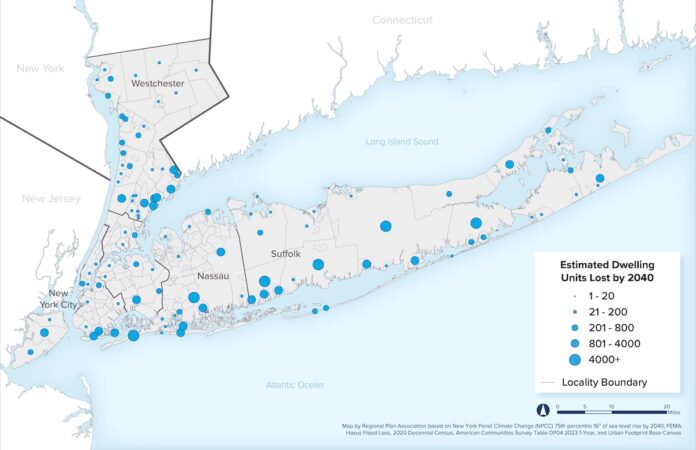“New York City and Long Island Facing Devastating Loss of Homes to Flooding by 2040, Report Warns”
The report released by the Regional Plan Association (RPA) on Monday highlighted the alarming prediction that by the year 2040, New York City and Long Island could lose over 80,000 homes to flooding. This loss of homes is expected to exacerbate the existing housing shortage in the area, which could reach 1.2 million homes.
The report emphasized that restrictive zoning regulations have contributed to the housing crisis by imposing procedural requirements, banning multi-family housing, and creating technical hurdles. Climate hazards, particularly flooding, are projected to worsen the housing shortage as the risk of climate-driven flooding continues to increase.
The New York City area has been experiencing a shortage of homes over the past few decades, leading to higher rents and home prices. The city has also struggled to adapt to the rising frequency of flooding and extreme weather events due to global heating.
According to the report, almost one million multifamily buildings and houses in the New York, Connecticut, and New Jersey tri-state area are at high risk of flooding. By 2050, the number of at-risk affordable housing units in coastal areas is expected to triple as greenhouse gas emissions continue to rise.
The report recommended zoning reform and policy changes to address the dual challenges of climate adaptation and housing needs in the study area. It highlighted that flood risks could have the most significant impact, with over 82,000 housing units at risk of being lost by 2040 due to permanent, chronic, and coastal flooding.
In Long Island, more than half of the residences predicted to be destroyed by 2040 are located, with waterfront neighborhoods in Brooklyn and Queens facing the most significant flooding losses. Some new developments in Queens’ Rockaway Peninsula have been implementing measures to safeguard against flooding while providing dense, affordable housing.
Mitigation measures in New York City, such as engineered berms in the Rockaways and floodgates and walls on Manhattan’s Lower East Side, are in various stages of completion. The report stressed the need for additional housing units to address overcrowding, provide shelter for those in need, and account for flooding losses, household formation changes, and dilapidation.
Experts emphasized the importance of denser, energy-efficient housing and the need to rethink traditional housing models in the face of climate change. Local officials were urged to consider clustering growth in regional areas with lower flood risks and close proximity to commercial hubs and public transportation.
Overall, the report painted a concerning picture of the future housing and climate challenges facing New York City and Long Island, calling for urgent action to address these pressing issues.
